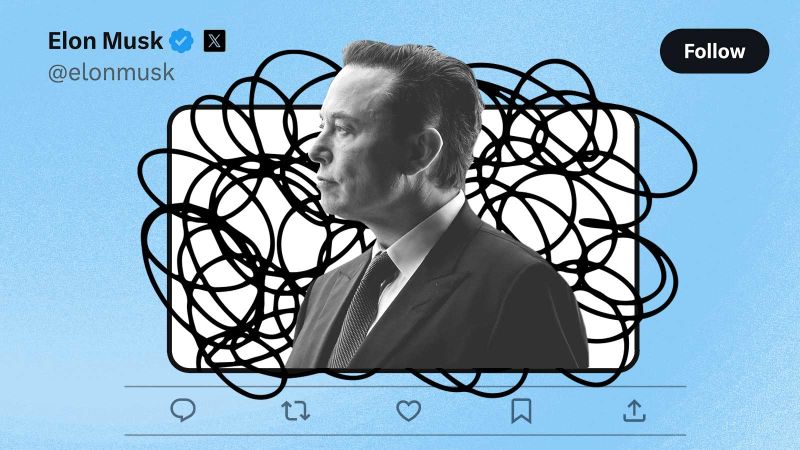You’d be forgiven for failing to remember every twist and turn — every controversial post, weird office update, legal threat and policy rollout (and, sometimes, rollback) — that took place during Elon Musk’s first year owning Twitter.
Since Musk closed his $44 billion deal to buy Twitter on October 27 of last year, he has not only rebranded the company as “X” but fundamentally changed what was once one of the world’s most prominent and influential platforms for real-time news and information. By extension, he’s also shifted the social media landscape writ large, as Twitter’s splintering audience seeks alternatives.
Here’s a look back at some of the highlights of Musk’s year owning the company, told through tweets — er, Xs?
Following a months-long legal battle attempting to extract himself from his agreement to buy Twitter, which Musk himself had initiated, Musk showed up at Twitter’s San Francisco headquarters on October 26 carrying a bathroom sink. He tweeted, “let that sink in!” and it seemed like the deal might finally come to a close. Musk reportedly told employees he met with that day that he didn’t plan to cut 75% of the company’s staff, as had previously been reported.
The following evening, Musk officially closed the deal. He tweeted “the bird is freed.” That day, he also told Twitter advertisers that he didn’t want the platform to become “a free-for-all-hellscape where anything can be said with no consequences” despite his promise to bolster “free speech.”

Within days of taking over Twitter, Musk ousted many of its top executives and then laid off half of the company’s staff via email, including employees in key departments such as ethical AI, communications, search, public policy, curation and platform wellness. Later in the month, he conducted a second round of layoffs by asking remaining employees to commit to working “extremely hardcore,” and cut those who didn’t.
In the days following Musk’s takeover, some of Twitter’s biggest advertisers also began pausing their spend on the platform over concerns about the layoffs, what Musk’s “free speech” vision would mean for content moderation and general uncertainty about the company’s future. On November 9, Musk held a Twitter Spaces call to plead with advertisers to remain on the platform. The same day, he tweeted, perhaps prophetically: “Please note that Twitter will do lots of dumb things in the coming months. We will keep what works and change what doesn’t.”
During that same month, Twitter launched its first iteration of paid verification to almost immediate chaos. Musk also restored former President Donald Trump’s Twitter account following an unscientific poll of his followers, but said he wouldn’t bring back conspiracy theorist Alex Jones.

December brought us the start of the so-called “Twitter Files,” a series of reports from independent journalists whom Musk hand picked to look through select internal Twitter documents. Despite several days of fervent attention to the reports, they revealed little new information about the company and its former leadership.
Rolling layoffs at the company continued. Musk began a mass unbanning of previously suspended Twitter accounts, including members of the far-right and users who’d shared misinformation.
Mid-month, Musk temporarily suspended several prominent journalists from Twitter for posting about @ElonJet, an account run by a teen that had posted the updated locations of Musk’s private yet. The move drew blowback and called into question his stated commitment to free speech. The company also introduced a policy, which was quickly rolled back, banning links to other social media platforms.
Musk also polled his followers about whether he should step down as Twitter’s CEO. The majority voted “yes,” and he said he just had to “find someone foolish enough to take the job!”
January was — blissfully — a relatively quiet month in Twitter-land, although the company did get sued by a landlord for alleged nonpayment of rent.

Musk kicked off February by announcing that Twitter would charge for access to its API, angering researchers who had long used the tool to measure platform manipulation. Public safety officials worried that they’d lose the ability to alert the public of threats like earthquakes and transit issues; eventually, Twitter reversed course and allowed government institutions to use the API for free. Twitter also announced plans to allow only paid users to have text message two-factor authentication, upsetting some users.
Musk hinted at Twitter’s financial troubles saying, “I acquired the world’s largest non-profit for $44 billion.” (Twitter had, in fact, reported a profit in 2018 and 2019, prior to Musk’s takeover.)

On March 1, thousands of Twitter users were unable to view their timelines because of a glitch. Five days later, it happened again — this time affecting users’ ability to see photos and click through links and, in some cases, access the site entirely. Musk chalked it up to the platform being “brittle” (rather than his layoffs of many employees charged with keeping the site operational).
Musk took heat for publicly mocking an employees’ disability, after the employee tweeted at him, confused about whether he’d been laid off. Musk later backtracked and apologized.
Also this month, the FTC confirmed it was investigating Twitter’s privacy practices, and Twitter said part of its proprietary source code had leaked online.
At the end of March, Twitter followed through on Musk’s earlier promise to open-source part of its source code in an effort to help users understand the platform’s recommendation algorithm.
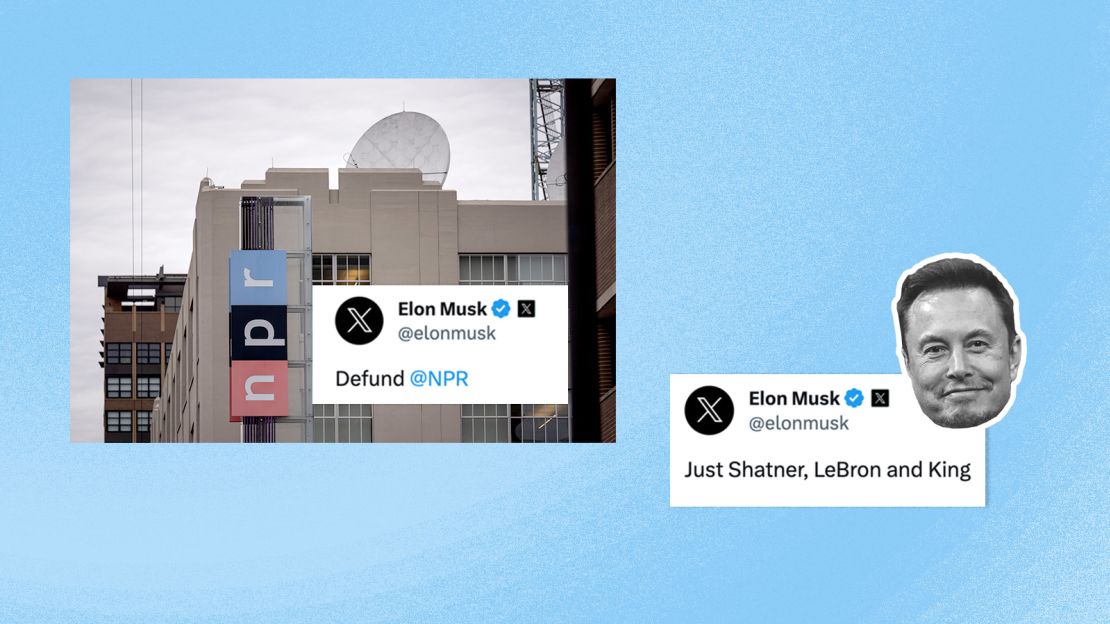
Musk and Twitter got into a spat with NPR, and several other public broadcasters, after rolling out a new label calling them “state-affiliated media,” the same way it identified foreign propaganda outlets such as Russia’s RT and Sputnik. Twitter eventually changed the label to “government-funded media” and then did away with the designation altogether, but NPR and PBS left the platform nonetheless.
Former Twitter executives, including former Twitter CEO Parag Agrawal, sued the company to recover legal expenses. Musk told the BBC he had laid off 80% of Twitter’s staff since his takeover and that the company was “roughly breakeven.”
And on 4/20 — a day Musk likes to giggle about for its connection to a marijuana holiday — Twitter removed the verification checkmarks from users who’d been authenticated under the company’s old system. Quickly, some prominent users were impersonated and others tweeted their frustrations. Musk said the move was meant to eradicate bots, with the added perk of incentivizing users to pay up for the platform’s subscription service. But the move marked the beginning of a radically different information regime on Twitter, making it more difficult for users to determine a verified account’s authenticity and trust what they see on the site.
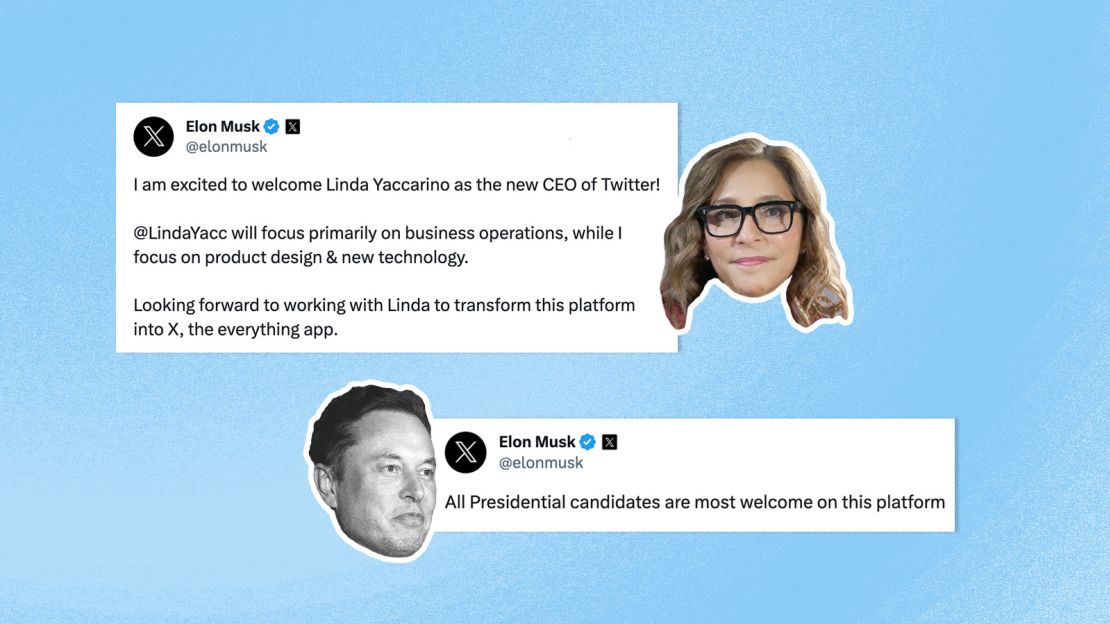
May began with Twitter founder Jack Dorsey saying he no longer thought Musk was the right person to run Twitter.
Lucky for him, just over a week later Musk announced he’d found a new CEO for the company in former NBCUniversal ad exec Linda Yaccarino (although Musk retains ultimate control over the company).
May also brought us Florida Gov. Ron DeSantis’ campaign launch on a Twitter Spaces event with Musk, which was plagued by glitches, echoing audio and, in the words of a Musk lieutenant, “melting servers.”
Fidelity released a report estimating that Twitter was worth only one-third of its pre-Musk value.
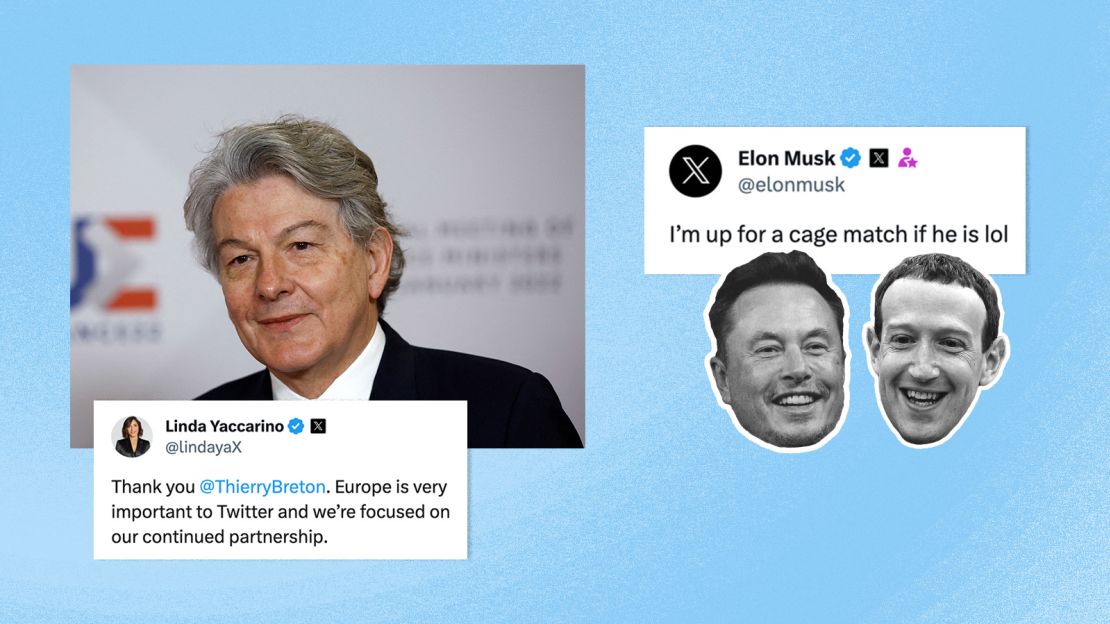
Musk in June said that he’d be “up for a cage fight” with Meta CEO Mark Zuckerberg, kicking off weeks of will-they, won’t-they, they-probably-won’t discourse on and offline.
In more serious matters, EU Commissioner Thierry Breton visited Twitter’s headquarters to conduct a stress test for the new Digital Services Act regulating everything from social media content moderation to targeted advertising, which officially went into effect two months later. The visit was an early test for Yaccarino, less than a month after she officially took over as CEO.
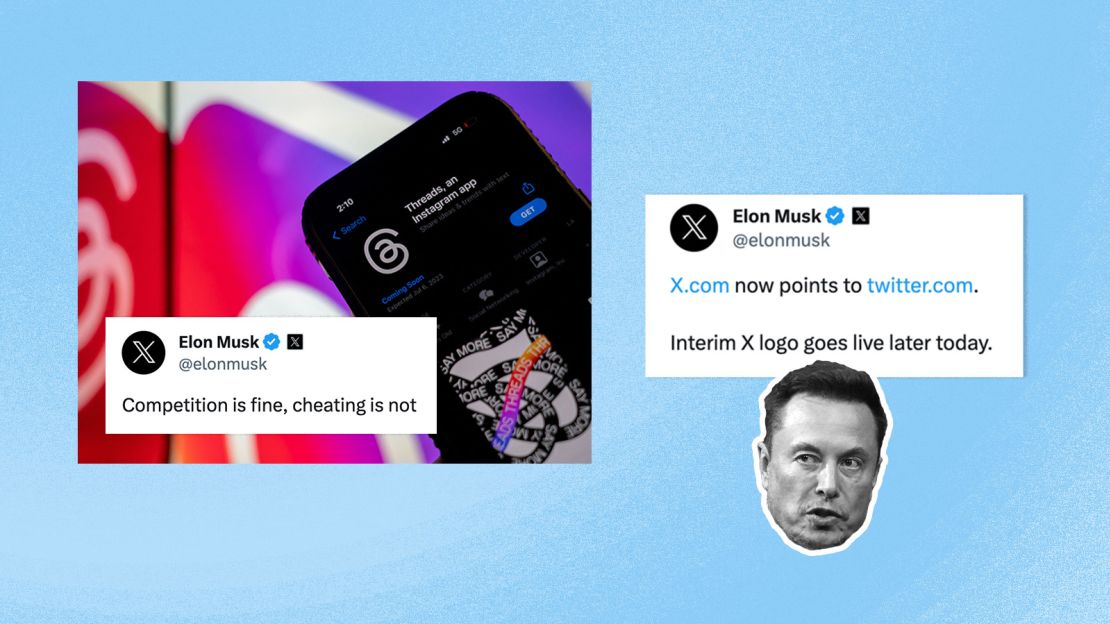
On July 6, Meta launched Threads, its competitor app to Twitter and perhaps the biggest threat to the bird app since Musk’s acquisition. Threads quickly took off, gaining millions of signups within days of its launch (although engagement has been slower to catch up in the months since).
Sensing the threat, Musk threatened to sue Meta over Threads, calling it “cheating.” The lawsuit never materialized.
Twitter this month launched its controversial creator ad revenue share program. Musk said Twitter remained cash flow negative because of its heavy debt load and a 50% decline in ad revenue.
And then, Musk rebranded Twitter as “X” and doubled down on his vision to make the platform into an “everything app” for communications, entertainment and payments. The city of San Francisco, however, did not appreciate the giant, blinking
“X” sign that was affixed to the top of the company’s headquarters, and quickly had it removed.
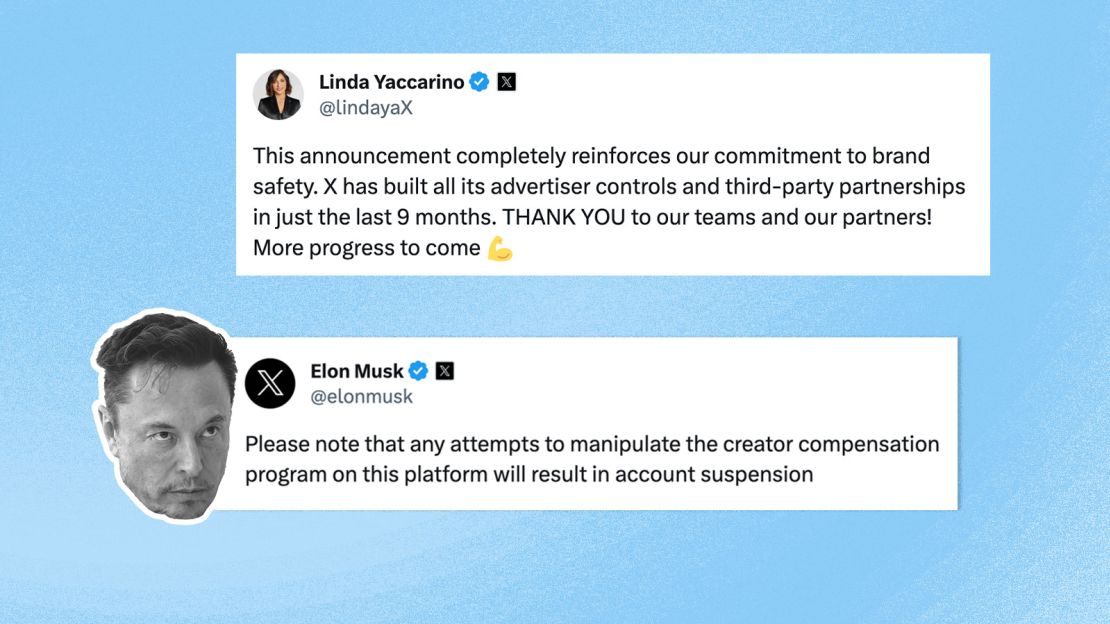
As Twitter, now X, continued to struggle to lure advertisers back to the platform, Yaccarino teased new brand safety controls meant to allow advertisers to restrict the kinds of content their ads could appear next to. She also said X was “close to breakeven.”
Days later, two brands halted their spending on the platform after their ads appeared on a pro-Nazi account. (X said the account and ads were not widely viewed, and that it was improving its brand safety controls.)
The company also sued the Center for Countering Digital Hate, a watchdog that had reported about a rise in hateful content on the platform, accusing the group of trying to drive advertisers away from the platform. (CCDH is fighting the suit.)
Issues also started to emerge with X’s creator ad revenue share program. Under the platform’s new paid verification scheme, users who subscribed for a blue check already had their posts boosted by the platform’s algorithm. Now, the possibility to be paid for posts that garnered significant engagement threatened to incentivize users to post inflammatory content. Musk warned users not to attempt to manipulate the program.
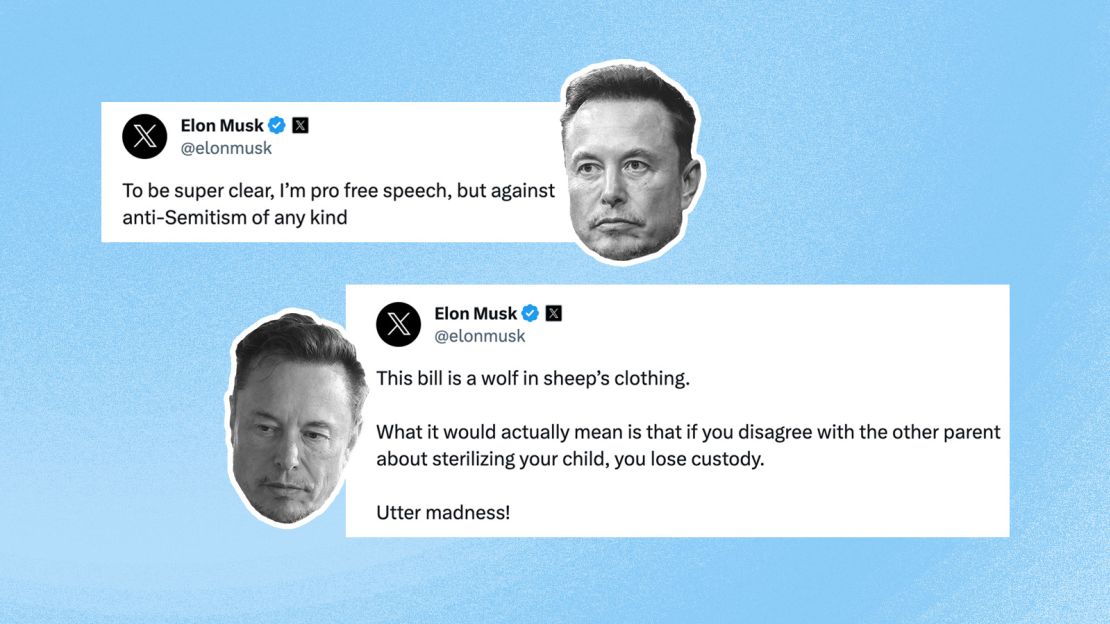
Musk threatened to sue the Anti-Defamation League for defamation, claiming that the nonprofit organization’s statements about rising hate speech on the social media platform have torpedoed X’s advertising revenue. (He said US advertising revenue remained down 60%.) Musk also liked and engaged with a series of posts criticizing the organization. A #BanTheADL campaign spread on X, and the ADL accused Musk of “lifting” the campaign.
No lawsuit was ever filed and the ADL, after pushing back firmly on Musk’s claims, eventually appeared to make nice with the platform and resumed advertising on X.
In the meantime, Musk posted to reassure his followers that his fight with the organization did not mean he is antisemitic.
That month, X did sue California’s Attorney General over the state’s new content moderation law, which Musk called “a wolf in sheep’s clothing.”
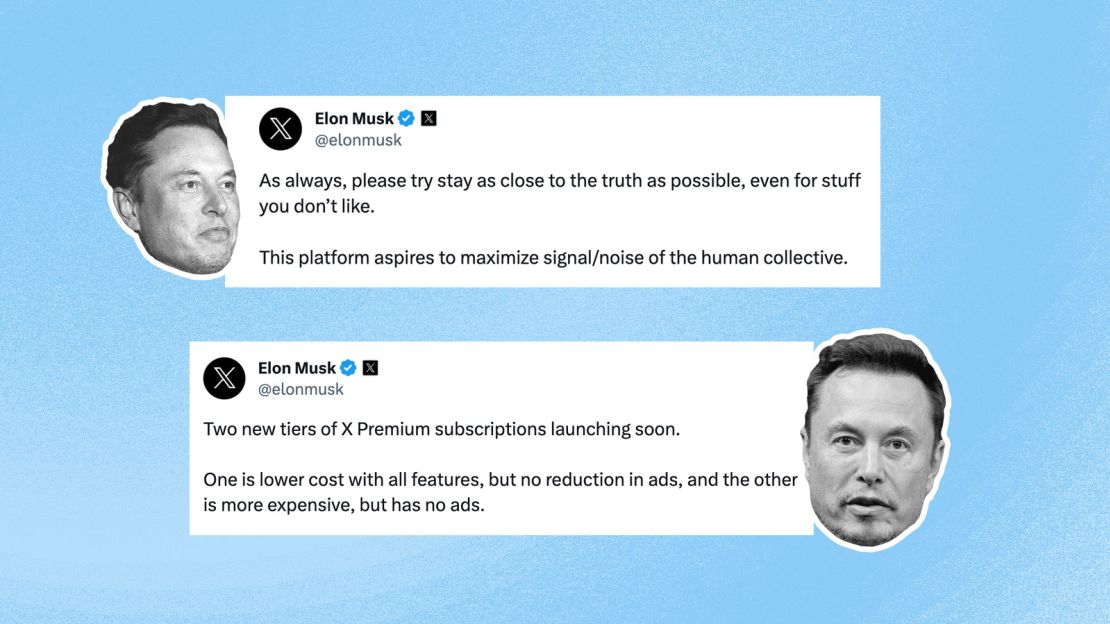
False and misleading claims spread rapidly on X in the days following the outbreak of the Israel-Hamas war. Musk, in a since-deleted post, pointed users to known spreaders of disinformation for updates about the war, and later Musk asked users to stay “close to the truth” in posts about the conflict. The company’s leaders also touted X’s “Community Notes” feature that allows users to provide context notes on other users’ posts.
The European Union officially launched an investigation of X after a previous warning about disinformation and illegal content on its platform linked to the Israel-Hamas war. (X, for its part, says it has removed “hundreds of Hamas-affiliated accounts” and taken down thousands of posts related to the conflict in recent weeks.)
In a continued effort to boost X’s profits with subscription revenue, Musk announced plans to roll out multiple tiers of its Premium service, including a more expensive, ad-free tier.
On Thursday night — the eve of the one-year anniversary of Musk’s Twitter takeover — Yaccarino said in a blog post that she is “incredibly proud of the work our team has been doing” and teased “the scope of our ambition for next year.”
And on Friday, at around midnight, Musk posted noting the “good progress” the company’s engineering team has made over the past year.
Later Friday morning, Musk revived his year-old “bird is freed” tweet, saying “Freedom.” But minutes later, he was out of celebration mode and back to his usual Twitter persona, riling up his increasingly right-wing fanbase: Musk, in a post responding to another user, implied that some people want the “extinction” of the descendants of Confederate Leader Robert E. Lee.
Read the full article here


